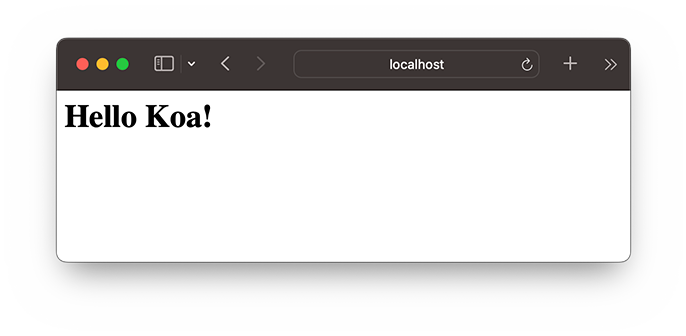koa入门
创建koa工程
首先,我们创建一个目录hello-koa,作为koa工程根目录。
在根目录下执行npm install koa,我们就在当前目录下安装好了koa及其依赖项,执行完成后目录结构如下:
hello-koa/
├── node_modules/ <-- koa以及所有依赖项
├── package-lock.json
└── package.json <-- npm描述文件
package.json包含了npm的依赖信息,以及项目描述等信息,package-lock.json是针对当前所有依赖的一个快照,目的是锁定各个依赖项的版本号。
我们打开package.json,内容如下:
{
"dependencies": {
"koa": "^2.15.3"
}
}
它只有一个koa依赖,是由命令npm install koa写入的。
node_modules是所有依赖项安装的地方,可以随时删除node_modules目录,然后用npm install重新安装。
直接运行npm install则根据package.json的dependencies信息下载安装依赖项,运行npm install xyz则将xyz添加到dependencies然后再安装xyz及其依赖项。因此,熟练的开发者可以先自己编辑dependencies内容,然后删除node_modules后重新安装所有依赖项。此外,package.json和package-lock.json应当添加至版本控制系统中,而node_modules则无需添加。
我们手动添加如下信息至package.json:
{
"name": "hello-koa",
"version": "1.0",
"description": "Hello koa webapp.",
"type": "module",
"dependencies": {
"koa": "^2.15.3"
}
}
其中,name、version和description均可任意设置,type为module表示以ESM模块执行。
紧接着,我们用VS Code打开hello-koa目录,创建app.mjs文件,输入以下代码:
// 导入koa,注意导入的是大写开头的class:
import Koa from 'koa';
// 创建一个koa实例表示webapp本身:
const app = new Koa();
// 对于任何请求,app将调用该异步函数处理请求:
app.use(async (ctx, next) => {
await next();
// 设置响应类型和文本:
ctx.response.type = 'text/html';
ctx.response.body = '<h1>Hello Koa!</h1>';
});
// 在端口3000监听:
app.listen(3000);
console.log('app started at port 3000...');
对于每一个http请求,koa将调用我们传入的异步函数来处理:
async (ctx, next) => {
await next();
// 设置response的Content-Type:
ctx.response.type = 'text/html';
// 设置response的内容:
ctx.response.body = '<h1>Hello Koa!</h1>';
}
其中,参数ctx是由koa传入的封装了request和response的变量,我们可以通过它访问request和response,next是koa传入的将要处理的下一个异步函数。
上面的异步函数中,我们首先用await next();处理下一个异步函数,然后,设置response的Content-Type和内容。
现在,我们的工程结构如下:
hello-koa/
├── node_modules/
├── app.mjs
├── package-lock.json
└── package.json
在命令行执行node app.mjs就启动了Web服务器。我们打开浏览器,输入http://localhost:3000,即可看到效果:

koa middleware
让我们再仔细看看koa的执行逻辑。核心代码是:
app.use(async (ctx, next) => {
await next();
ctx.response.type = 'text/html';
ctx.response.body = '<h1>Hello Koa!</h1>';
});
每收到一个http请求,koa就会调用通过app.use()注册的async函数,并传入ctx和next参数。
我们可以对ctx操作,并设置返回内容。但是为什么要调用await next()?
原因是koa把很多async函数组成一个处理链,每个async函数都可以做一些自己的事情,然后用await next()来调用下一个async函数。我们把每个async函数称为middleware,这些middleware可以组合起来,完成很多有用的功能。
例如,可以用以下3个middleware组成处理链,依次打印日志,记录处理时间,输出HTML:
app.use(async (ctx, next) => {
console.log(`${ctx.request.method} ${ctx.request.url}`); // 打印URL
await next(); // 调用下一个middleware
});
app.use(async (ctx, next) => {
const start = Date.now(); // 当前时间
await next(); // 调用下一个middleware
const ms = Date.now() - start; // 耗费时间
console.log(`Time: ${ms}ms`); // 打印耗费时间
});
app.use(async (ctx, next) => {
await next();
ctx.response.type = 'text/html';
ctx.response.body = '<h1>Hello Koa!</h1>';
});
middleware的顺序很重要,也就是调用app.use()的顺序决定了middleware的顺序。
此外,如果一个middleware没有调用await next(),会怎么办?答案是后续的middleware将不再执行了。这种情况也很常见,例如,一个检测用户权限的middleware可以决定是否继续处理请求,还是直接返回403错误:
app.use(async (ctx, next) => {
if (await checkUserPermission(ctx)) {
await next();
} else {
ctx.response.status = 403;
}
});
理解了middleware,我们就已经会用koa了!
最后注意ctx对象有一些简写的方法,例如ctx.url相当于ctx.request.url,ctx.type相当于ctx.response.type。